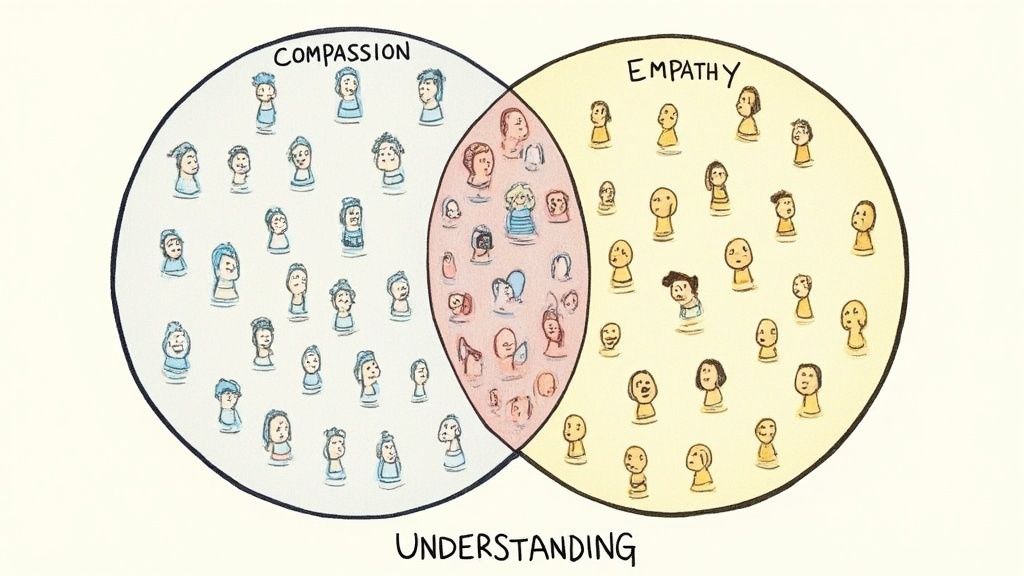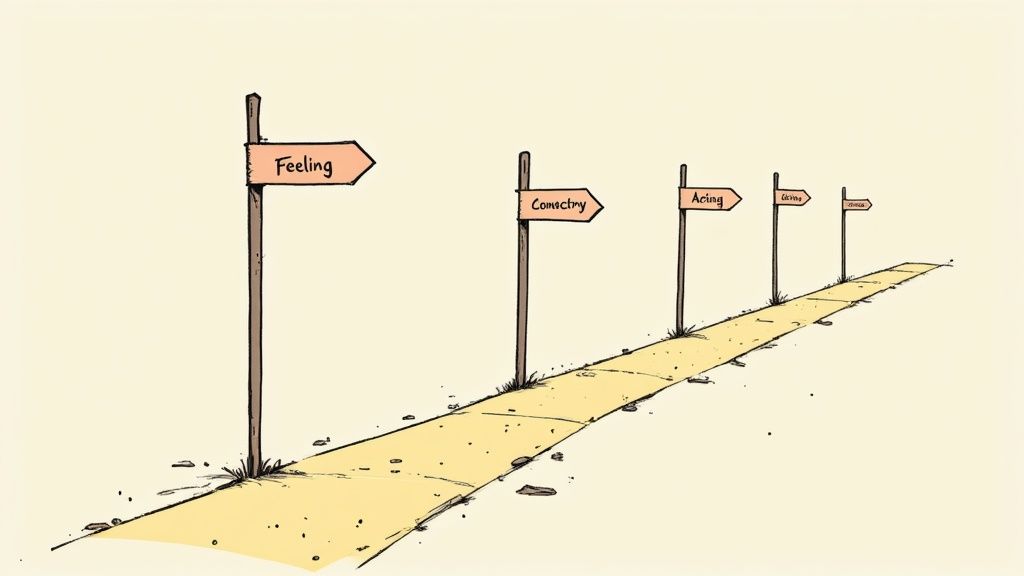Compassion vs Empathy: A Practical Guide to Understanding Their Transformative Impact


The Fascinating Science Behind Compassion vs Empathy

While peple often use compasion and empthy interchangably, brain scince shows they actualy work quite diffrently in our minds. Understanding these diffrences helps us navgate relatnships better and maintan our emotonal health. For instance, empthy can drain our enegy, while compasion often gives us a bost. So what's really hapening in our brains?
Neurological Differences: Empathy vs Compassion
When we empathize, we essentially "feel with" someone by mirroring their emotional state. This creates strong connections but can become overwhelming, especially when facing others' intense pain. Without proper boundaries, this mirroring effect may lead to empathic distress - feeling emotionally drained and overwhelmed.
Compassion works differently - it's more about "feeling for" someone while maintaining healthy emotional distance. When we feel compassion, we recognize suffering and want to help, but we don't absorb the other person's emotional state. This key difference allows us to support others effectively without burning out ourselves.
A 2013 brain imaging study examined how our brains respond when experiencing pain versus watching a loved one in pain. The research found that empathy activates emotional brain regions that mirror others' pain. In contrast, compassion lights up areas linked to positive feelings and social connection. Learn more about the neuroscience of empathy and pain here.
The Impact of Emotional Resonance
These brain differences significantly affect our wellbeing. Too much empathic distress can cause burnout and withdrawal, making it hard to maintain supportive relationships. This is particularly relevant for caregivers and healthcare workers who regularly face others' suffering.
On the flip side, practicing compassion activates reward centers in our brains, creating positive feedback that encourages more compassionate actions. This means showing compassion not only helps others but also nurtures our own emotional resilience and sense of purpose. By grasping these key differences between compassion and empathy, we can build stronger connections while protecting our emotional health.
Understanding Compassion and Empathy in Mental Health

Our emotional responses shape our mental health in significant ways. While both compassion and empathy help us connect with others, they affect our wellbeing quite differently. Understanding these differences is key to developing healthy caring practices.
How Empathy Can Drain Us
When we empathize, we deeply share someone else's emotional state. While this creates meaningful connections, it can also overwhelm us. Consider a therapist who absorbs their clients' fears and traumas day after day. This emotional mirroring often leads to burnout and mental exhaustion, making it harder to help others effectively.
Why Compassion Helps Us Stay Strong
Compassion takes a different approach - it's about recognizing suffering and wanting to help, without taking on the other person's emotional load. This creates healthy boundaries while still allowing us to support others. For people in helping roles like healthcare or social work, compassion offers a more sustainable way to care.
The effects of compassion versus empathy on mental health are quite distinct. Too much empathy, especially with negative emotions, can increase stress and lead to emotional drain. Sometimes this stress becomes so intense that people withdraw completely. In contrast, compassion tends to create positive feelings of warmth and connection. It motivates us to help others while protecting our own wellbeing. Learn more about these differences here.
Building Mental Strength Through Compassionate Care
The first step toward better mental health is noticing when we're becoming emotionally drained. This awareness helps us develop better coping skills. Using mindful response - observing our emotions without judgment - can help us tell the difference between empathy and compassion. This lets us choose how deeply we engage with others' feelings.
By understanding how compassion and empathy affect us differently, we can develop a balanced approach to caring for others and ourselves. This mindful way of connecting leads to better mental health and stronger relationships.
Improving Healthcare Through Compassionate Care
Quality healthcare requires a deep understanding of human suffering. While empathy has its place, evidence shows that compassion leads to better outcomes for both patients and providers. Leading medical centers are discovering that compassion-focused care improves patient experiences and staff wellbeing. Let's explore why compassion makes such a difference in healthcare settings.
Understanding Compassion vs Empathy in Healthcare
When providers empathize by feeling patients' emotional pain, they risk becoming overwhelmed and burned out. Compassion offers a more balanced approach. It allows caregivers to recognize suffering and help relieve it, without absorbing the emotional burden. This helps providers maintain their own wellbeing while delivering excellent care.
Consider a nurse caring for someone with terminal illness. Pure empathy could cause the nurse to deeply feel the patient's despair, leading to emotional exhaustion. With compassion, the nurse can validate the patient's experience while staying emotionally resilient enough to provide consistent, high-quality care. This key difference between compassion and empathy significantly impacts healthcare delivery.
Key Benefits of Compassionate Care
Focusing on compassion in healthcare provides several important advantages:
Better Health Outcomes: When patients feel genuinely supported by compassionate caregivers, they're more likely to follow treatment plans and heal in a positive environment
Less Provider Burnout: Compassionate care helps protect healthcare workers from emotional exhaustion and trauma
Stronger Teams: A compassionate culture improves communication and collaboration between medical staff
Higher Job Satisfaction: Healthcare providers who practice compassion report finding more meaning and fulfillment in their work
Research from the UK's National Health Service (NHS) demonstrates these effects. A study of NHS emergency medicine consultants found that those with lower compassion scores showed more irritability and reduced care quality. Among 1317 providers surveyed, 52% reported average or higher compassion satisfaction. However, those with lower scores were 59% more likely to consider early retirement. Learn more about the research here.
Bringing Compassion into Healthcare Practice
Making compassion central to healthcare requires several key elements:
Mindfulness Training: Teaching mindfulness helps providers develop self-awareness and emotional balance
Communication Skills: Training in effective communication enables providers to express compassion authentically
Supportive Environment: Healthcare organizations must foster a culture that encourages teamwork and open dialogue
By making compassion a core value, medical institutions can improve patient care while creating a more rewarding environment for their staff.
Mastering the Art of Compassionate Response

Let's explore practical ways to develop compassionate responses in our daily lives. The goal is to learn how to care for others effectively while protecting ourselves from emotional exhaustion. By building specific skills and practices, we can create sustainable ways to help others while maintaining our own wellbeing.
Cultivating Compassion Through Practice
While empathy often happens automatically, compassion is a skill we can actively develop. Just like learning any new ability, it takes regular practice and commitment. The good news is that we can train ourselves to respond with care without becoming overwhelmed by others' emotions.
You can build compassion through structured activities like meditation and mindfulness, or through everyday actions like active listening and offering support. The key is finding ways to practice that feel natural and sustainable for you.
Try starting with a simple daily reflection on our shared human experiences. Think about how we all face similar challenges and emotions, regardless of our backgrounds. This helps build genuine connections with others and develops a deeper sense of our common humanity.
Making time for activities that support your own wellbeing is equally important. Whether it's walking in nature or engaging in creative hobbies, self-care builds your capacity for compassion. When you feel grounded and balanced, you're better equipped to help others.
Studies show that even brief compassion practices can make a real difference. According to research, just one week of compassion training increased helpful behaviors in participants. Learn more about the research here.
Transforming Empathy into Compassion
Most of us naturally respond with empathy when we see someone suffering. However, constantly absorbing others' negative emotions can drain us emotionally. The key is learning to shift from empathy to compassion.
This transition involves noticing our empathetic response, understanding when it might become overwhelming, and purposefully moving toward compassionate action. Instead of just feeling what others feel, we focus on how we can help while maintaining healthy boundaries.
Here are key practices for making this shift:
Setting healthy boundaries: Know your emotional limits and take care of yourself first
Focusing on action: Channel your concern into practical ways to help
Practicing self-compassion: Be as kind to yourself as you are to others
By developing these skills, you can create a sustainable approach to caring that benefits everyone involved. This creates positive momentum - the more you practice compassion effectively, the more natural and energizing it becomes.
Creating Lasting Connections Through Balanced Response
The ability to balance empathy and compassion is key for creating meaningful relationships in both personal and professional life. Finding the right mix of heartfelt support while maintaining healthy boundaries can turn difficult conversations into chances to deepen connections.
Recognizing Emotional Cues for Deeper Connections
Building strong relationships requires picking up on and appropriately responding to emotional signals. When a friend shares a struggle, you have two options - you can empathize by deeply feeling their pain alongside them (which can be draining), or respond with compassion by acknowledging their pain and offering help while maintaining emotional distance.
Taking a thoughtful approach allows you to provide meaningful support without becoming overwhelmed. This distinction matters because constantly absorbing others' difficult emotions can lead to burnout and exhaustion over time.
Shifting From Empathy to Compassion: A Practical Approach
Moving from empathy to compassion is a skill you can develop. Start by checking in with your own emotional state and capacity. If you notice yourself getting overwhelmed by someone's feelings, pause and consciously shift from feeling with them to feeling for them.
This small change helps create healthy emotional space while still showing you care. Focus on concrete ways to help - whether that's listening without judgment, offering practical assistance, or simply being present with them through a difficult time.
Building Stronger Relationships Through Balanced Responses
When you find the right balance between empathy and compassion, relationships naturally deepen and grow stronger. You can offer authentic support while protecting your own wellbeing, which creates lasting bonds built on mutual understanding.
Consider this real example: A man regularly passed someone experiencing homelessness during his daily walks. Rather than just giving money, he made a point to acknowledge the person's basic humanity and dignity through simple greetings and conversation, even across language barriers. This small act of connection and recognition had a profound impact.
By learning to blend empathy with compassion skillfully, you create meaningful relationships grounded in respect, understanding and sustainable support. This balanced approach benefits both the person receiving care and protects your own emotional resources, allowing you to maintain healthy connections in all parts of your life.
Implementation Strategies for Lasting Change

Putting compassion into practice requires specific techniques and consistent effort. This section provides practical methods for developing compassionate responses in your daily interactions. You'll learn how to spot key moments for compassionate action and build sustainable habits.
Recognizing Opportunities for Compassionate Action
Learning to identify situations where compassion works better than empathy is essential. Consider when a coworker shares their work frustrations - rather than absorbing and amplifying their stress through empathy, you can acknowledge their feelings while maintaining perspective. This allows you to provide real support without becoming drained.
Look for these chances to practice compassion:
Personal Relationships: Support loved ones by listening actively and offering concrete help when needed. Small acts of support build stronger connections.
Professional Settings: Show understanding for colleagues' challenges while focusing on solutions. This creates a more positive work environment.
Community Service: Help others through volunteer work or simple kind gestures. Even brief supportive interactions make a difference.
Practical Techniques for Cultivating Compassion
Use these specific methods to shift from empathy to compassion:
Stay Self-Aware: Notice when others' emotions start overwhelming you. Take a pause to reset and choose a balanced response.
Keep Healthy Boundaries: Accept that you can care without taking on others' pain completely. Your wellbeing matters too.
Take Helpful Action: Rather than just feeling bad together, ask "What support do you need?" This moves the interaction forward constructively.
Maintaining Your Compassion Practice
Building compassion requires ongoing dedication, like developing any skill. Try these strategies:
Daily Check-Ins: Briefly review your interactions each day. Note moments of compassion and areas for growth. This builds self-knowledge.
Simple Meditation: Regular mindfulness practice helps you stay present and manage emotions better. This builds your capacity for steady compassion.
Find Community: Connect with others working on similar goals. Sharing experiences helps deepen everyone's practice.
Using these approaches helps you shift naturally from empathy to compassion over time. This creates more sustainable relationships and builds your own emotional strength. Ready to develop your coaching skills further? Visit Coaching Hub for helpful resources on compassionate communication.